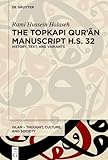The Topkapı Qurʾān Manuscript H.S. 32 : History, Text, and Variants / Rami Hussein Halaseh.
Material type: TextSeries: Islam – Thought, Culture, and Society ; 7Publisher: Berlin ; Boston : De Gruyter, [2024]Copyright date: 2024Description: 1 online resource (XIX, 280 p.)Content type:
TextSeries: Islam – Thought, Culture, and Society ; 7Publisher: Berlin ; Boston : De Gruyter, [2024]Copyright date: 2024Description: 1 online resource (XIX, 280 p.)Content type: - 9783111455259
- 9783111467429
- 9783111467320
- 297.1/224042 23/eng/20240926
- BP100.3 .H35 2024
- online - DeGruyter
- Issued also in print.
| Item type | Current library | Call number | URL | Status | Notes | Barcode | |
|---|---|---|---|---|---|---|---|
 eBook
eBook
|
Biblioteca "Angelicum" Pont. Univ. S.Tommaso d'Aquino Nuvola online | online - DeGruyter (Browse shelf(Opens below)) | Online access | Not for loan (Accesso limitato) | Accesso per gli utenti autorizzati / Access for authorized users | (dgr)9783111467320 |
Browsing Biblioteca "Angelicum" Pont. Univ. S.Tommaso d'Aquino shelves, Shelving location: Nuvola online Close shelf browser (Hides shelf browser)

|

|

|

|

|

|

|
||
| online - DeGruyter Nominalization in Western Austronesian : Not-at-issueness in Totoli and Beyond / | online - DeGruyter Überlegungen zur Menschlichkeit Gottes : Ausgewählte Aufsätze / | online - DeGruyter Bayerisches Wörterbuch (BWB). Band 4/Heft 32, Tuch–türeln / | online - DeGruyter The Topkapı Qurʾān Manuscript H.S. 32 : History, Text, and Variants / | online - DeGruyter The Moderate Majority : Real GOP Voters and the Myth of Mass Republican Radicalization / | online - DeGruyter Contra Eutychetem / | online - DeGruyter Aufklärungsuniversitäten im Alten Reich? : Halle, Göttingen und der Wandel der deutschen Universität im 18. Jahrhundert / |
Frontmatter -- Contents -- Abbreviations and Miscellaneous Conventions -- Glossary -- Transliteration Scheme -- Chapter 1 Introduction -- Chapter 2 Codicology and Paleography -- Chapter 3 Orthography -- Chapter 4 Emendations in H.S. 32 -- Chapter 5 The Variants in H.S. 32 -- Chapter 6 Conclusion -- Plates -- Appendix I: Rosettes and Headbands -- Appendix II: Versification in H.S. 32 -- Appendix III: The Qirāʾāt in H.S. 32 -- Appendix IV: Orthographic Comparison -- Bibliography -- Index
restricted access online access with authorization star
http://purl.org/coar/access_right/c_16ec
This study presents a comprehensive and systematic examination of a revered Qurʾān manuscript, commonly attributed to the third Islamic Caliph, ʿUthmān b. ʿAffān (d. 35/656), housed at the Topkapı Palace Museum in Istanbul, Türkiye (identified as H.S. 32). Halaseh offers a meticulous analysis of the manuscript’s codicological, paleographic, and orthographic characteristics, explores its emendations, production date, and traces the manuscript’s journey first to Cairo and then to Istanbul. Additionally, the study examines and categorizes its textual variants, including what are considered today as non-canonical and some that are not previously attested in the major qirāʾāt literature. This work not only sheds light on the transmission of the Qurʾānic text but also establishes a comprehensive framework for researching Qurʾān manuscripts. By integrating methods for examining these manuscripts as both physical artifacts and scriptural texts, Halaseh presents a holistic methodological approach to their scholarly study.
Issued also in print.
Mode of access: Internet via World Wide Web.
In English.
Description based on online resource; title from PDF title page (publisher's Web site, viewed 20. Nov 2024)


